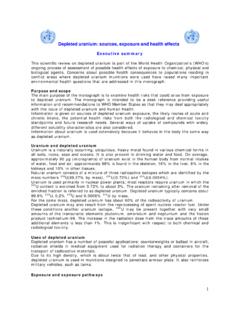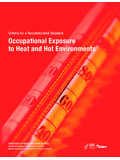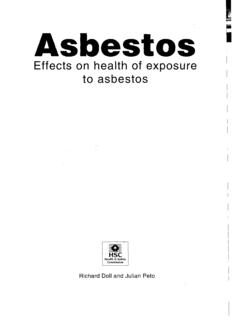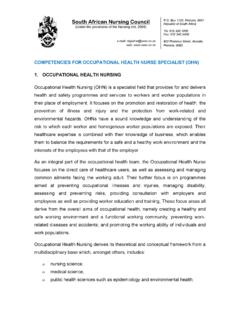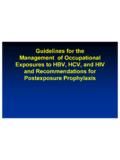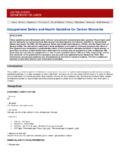Transcription of This document is in the public domain and may be …
1 This document is in the public domain and may be freely copied or reprinted. Disclaimer Mention of any company or product does not constitute endorsement by the National Insti-tute for occupational Safety and health (NIOSH). In addition, citations to Web sites external to NIOSH do not constitute NIOSH endorsement of the sponsoring organizations or their programs or products. Furthermore, NIOSH is not responsible for the content of these Web sites. Ordering Information To receive documents or other information about occupational safety and health topics, con-tact NIOSH at NIOSH Publications Dissemination 4676 Columbia Parkway Cincinnati, OH 45226 1998 Telephone: 1 800 35 NIOSH (1 800 356 4674) Fax: 513 533 8573 E-mail.
2 Or visit the NIOSH Web site at DHHS (NIOSH) Publication Number 2004 165 September 2004 SAFER HEALTHIER PEOPLETM ii Foreword The purpose of this Alert is to increase awareness among health care workers and their em-ployers about the health risks posed by working with hazardous drugs and to provide them with measures for protecting their health . health care workers who prepare or administer hazardous drugs or who work in areas where these drugs are used may be exposed to these agents in the air or on work surfaces, contaminated clothing, medical equipment, patient excreta, and other surfaces.
3 Studies have associated workplace exposures to hazardous drugs with health effects such as skin rashes and adverse reproductive outcomes (including infertility, spontaneous abortions, and congenital malformations) and possibly leukemia and other cancers. The health risk is influenced by the extent of the exposure and the potency and toxicity of the hazardous drug . To provide workers with the greatest protection, employers should (1) implement necessary administrative and engineering controls and (2) assure that workers use sound procedures for handling hazardous drugs and proper protective equip-ment.
4 The Alert contains a list of drugs that should be handled as hazardous drugs. This Alert applies to all workers who handle hazardous drugs (for example, pharmacy and nursing personnel, physicians, operating room personnel, environmental services workers, workers in research laboratories, veterinary care workers, and shipping and receiving person-nel). Although not all workers in these categories handle hazardous drugs, the number of exposed workers exceeds million. The Alert does not apply to workers in the drug manu-facturing sector. The production, distribution, and application of pharmaceutical medications are part of a rapidly growing field of patient therapy.
5 New areas of pharmaceutical development will bring fundamental changes to methods for treating and preventing diseases. Both traditional med-ications and bioengineered drugs can be hazardous to health care workers who must handle them. This NIOSH Alert will help make workers and employers more aware of these hazards and provide the tools for preventing exposures. John Howard, Director National Institute for occupational Safety and health Centers for Disease Control and Prevention iii Contents Foreword .. iii Background.
6 2 Potential for Worker Exposure .. 2 Conditions for Exposure .. 3 Exposure Routes.. 4 Evidence for Worker Exposure .. 4 Evidence for health Effects in Workers .. 5 Mutagenicity .. 6 Developmental and Reproductive Effects .. 6 Cancer.. 6 Current Standards and Recommendations.. 6 OSHA .. 7 EPA .. 7 Additional Guidelines.. 7 Case Reports .. 8 Case 1 .. 8 Case 2 .. 9 Case 3 .. 9 Case 4 .. 9 Case 5 .. 9 Conclusions .. 10 Recommendations .. 10 Summary of Recommended Procedures .. 10 Detailed Recommendations .. 11 Receiving and Storage.. 11 drug Preparation and Administration.
7 12 Initial steps .. 12 Preparing hazardous drugs.. 12 Administering hazardous drugs .. 14 Ventilated Cabinets .. 14 Use of cabinets .. 14 vii Selection .. 14 Air flow and exhaust .. 15 Maintenance .. 15 Routine Cleaning, Decontaminating, Housekeeping, and Waste Disposal .. 16 Cleaning and decontaminating.. 16 Housekeeping .. 17 Waste disposal.. 17 Spill Control .. 18 Medical Surveillance .. 18 Additional Information .. 19 Acknowledgments.. 19 References.. 20 Appendices A. Drugs Considered hazardous .. 31 General Approach to Handling hazardous Drugs.
8 31 Defining hazardous Drugs .. 31 ASHP Definition of hazardous Drugs .. 31 NIOSH Revision of ASHP Definition .. 32 Determining Whether a drug is hazardous .. 32 How to Generate Your Own List of hazardous Drugs .. 33 Where to Find Information Related to drug Toxicity .. 34 Examples of hazardous Drugs .. 34 B. Abbreviations and Glossary .. 41 C. NIOSH hazardous drug Safety Working Group .. 49 viii Preventing occupational Exposures to antineoplastic and other hazardous Drugs in health Care Settings Warning!
9 Working with or near hazardous drugs in health care settings may cause skin rashes, infertility, miscarriage, birth defects, and possibly leukemia or other cancers. The National Institute for occupational Saf ety and health (NIOSH) requests as-sistance in preventing occupational ex-posures to antineoplastic drugs (drugs use d to treat cancer) and other hazard-ous drugs in health care settings. health car e workers who work with or near haz-ardous drugs may suffer from skin rash-es, infertility, miscarriage, birth defects, and possibly leukemia or other cancers.
10 Workers may be exposed to hazardous drugs in the air or on work surfaces, clothing, medical equipment, and pa-tient urine or feces. The term hazardous drugs, as it is used in this Alert, includes drugs that are known or suspected to cause adverse health effects from ex-posures in the workplace. They include drugs used for cancer chemotherapy, antiviral drugs, hormones, some bio-engineered drugs, and other miscella-neous drugs. The health risk depends on how much exposure a worker has to these drugs and how toxic they are.










